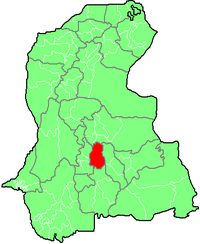Tando Allahyar District
|
Tando Allahyar District ضلعو ٽنڊو الهيار |
|
|---|---|
| District | |
 Map of Sindh with Tando Allahyar District highlighted |
|
| Country | Pakistan |
| Province | Sindh |
| Headquarters | Tando Allahyar |
| Population (2011 est.) | |
| • Total | 771,628 |
| Time zone | PST (UTC+5) |
| Number of Tehsils | 3 |
| Website | Tando Allahyar Official webpage |
Tando Allahyar District (Sindhi: ضلعو ٽنڊو الهيار) is a district in the province of Sindh in Pakistan. Prior to becoming a separate district, it was part of Hyderabad District.
The town was founded by Mir Allahyar Khan Talpur Qila was built in (1804). Tando Allahyar Old name is (qunday je wasi). 4 km away from Tando Allahyar there is found ancient monuments which is called ((Abul Jo Daro)) Abul was a king of old age.
The establishment of Tando Allahyar started with construction of a fort by Mir Allahyar Khan Talpur in 1709. The mud / clay fort is located at a distance of 3 kilometers from the current center of the town. This fort was built to look after his territory. A large number of people seeking security and refuge moved to this area under the protection of the Mir; these settlements gave the city a trading boom as well. As it progressed over the next decade this area started to be known as Allahyar Jo Tando (Allahyar's Town).
The shrine of old Sindhi legendary character of folk wisdom and Sufi poet Watayu Faqeer is also situated in Kuba Shareef near Rashidabad, Tando Allahar.
In 1906 during the British Raj, a railway station was established here. This step brought about a revolution in the town, increasing its importance as an agro-trading hub. It shaped Tando Allahyar to what it is now. From Allahyar Jo Tando it became Tando Allahyar.
The British Raj brought the fort of Mir Allahyar under its official use. (This fort is now known as the Kacho Qilo); however some decorated walls from the times of Mir Allahyar Khan are still present. Since 1933 after the construction of canal, the city of Tando Allahyar turned into an agricultural heaven. Before 1947 the city had large number of Hindu followers. The temple of Baba Ramdevji Rama-Pir was a symbol Hindu-Muslim unity and peaceful co-existence. However, after the Indian Partition a number of Hindu followers left for India. The temple still stands tall in the town center attracting hundreds of pilgrims from all around the region.
...
Wikipedia
